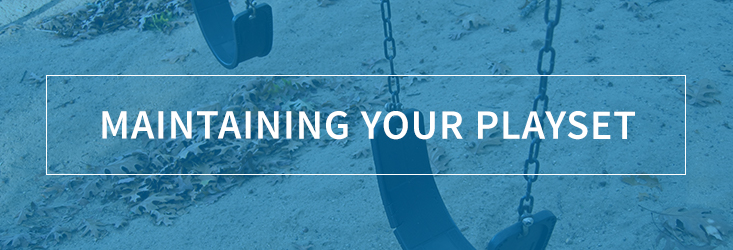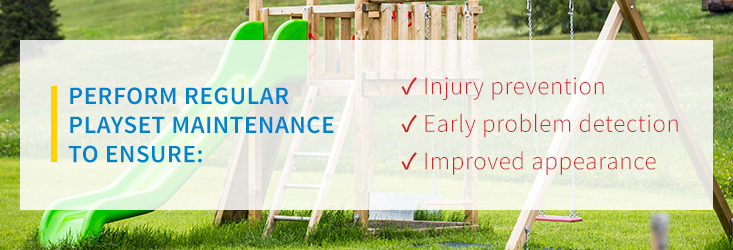August 11, 2020

Maintaining Your Playset
Your wooden swingset brings your kids endless active play opportunities. While wood is a durable material choice, it does require some maintenance to maximize the life of the playset. The constant exposure to weather elements eventually causes wear you can prevent or repair with regular maintenance tasks.
Why Playset Maintenance Is Important
Why is it important to take care of your wooden playset? There are many reasons, including protecting your investment. Investing your money in a wooden playset means you get a quality piece of play equipment. By performing regular maintenance, you keep the playset in peak condition to get the most out of your money.
Other reasons to perform regular playset maintenance include:
- Injury prevention: When you care for your equipment, you prevent serious problems with it that could potentially cause injuries. This benefit means you can have peace of mind letting your kids play on the equipment.
- Early problem detection: Over time, your playset may receive damage. When you perform regular maintenance, you can spot those issues early. This early detection lets you fix the problem before it becomes a major issue.
- Improved appearance: Cleaning, restaining and other care tasks keep your playset looking its best. You’ll be proud to have the playset in your yard when it continues to look like new thanks to your maintenance work.

How To Maintain Your Wooden Playset
1. Stain and Seal the Wood
Wood is a durable material — and some, like the Pacific cedar we use in our play structures, naturally resists damage from fungus, pests and other forms of damage. However, it’s still a good idea to seal all the wood to give it an extra layer of protection. That sealant is particularly important if you live in a climate with harsh weather conditions that can cause faster deterioration of the play equipment.
Staining is an option if you want to change the look of the structure and provide a little protection. Some play structures are already stained, but you’ll need to freshen up the color periodically. If you’re refreshing the playset to make it look like new, opt for a color that matches the wood’s natural hue. Restaining the play structure every two to three years keeps it looking like new. Before staining, wash the wood well to remove dirt and other debris. Let the wood dry for at least 24 hours before you start sealing or staining it. If the weather is damp or cool, wait even longer. If the wood is still damp, you’ll lock in the moisture and potentially cause faster deterioration.
When you stain your playset, start at the top. This method allows you to clean up any drips as you go, blending in the color for a uniform look. When staining the wood, be careful to avoid the metal and plastic components. Removing any detachable parts helps you avoid dripping the stain on those items. The stain is often difficult or impossible to remove from those other components once it gets on them, so it can affect the look of the play structure.
Sealants provide a layer of protection without changing the color of the wood. You usually need to reapply the sealant every one to three years, depending on the environment. Use a waterproof sealant on the wood to lock out moisture. The sealant helps minimize the amount of moisture that gets to the wood, which can prevent rotting, mold and other issues caused by the wetness.
Some sealants also protect the wood from UV rays, which provides additional protection that can make the playset last longer. The sun’s rays dry out the wood, potentially causing cracking and damage. UV rays also cause fading, which makes the playset look old. When possible, choose a waterproof sealant with UV protection designed for outdoor use.
When choosing stains or sealants, you’ll find both water-based and oil-based options. Oil-based options generally last longer and provide greater protection, but they also have stronger fumes than water-based options.
2. Do Regular Inspections
Regular inspections are an easy way to maintain your home play equipment. This maintenance step helps extend the life of the equipment and keep your kids safe by letting you spot any issues early. You may not notice small issues without a thorough inspection, so it’s worth your time to look a little closer.
Perform monthly inspections on play equipment that gets year-round use. If you stop using the playset in the winter, it’s important to do your first inspection in the spring before your kids start using the equipment again. You can then fall into the monthly inspection schedule for the remainder of the season.

To make your playground equipment inspection effective, look for specific issues:
- Check all bolts and screws to ensure they aren’t sticking out, have sharp edges or are broken.
- Tighten bolts and screws to ensure stability.
- Look at hooks and connections that hold swings and other detachable components.
- Check on ropes, chains and similar items.
- Inspect plastic parts to look for cracks or buckling.
- Check for rust on metal components.
- Lubricate moving metal parts for smooth motion.
- Look for splinters, cracks and rotting on wooden parts.
- Sand rough patches on the wood.
- Replace rotten or damaged boards.
- Ensure all protective coverings are still in place without any cracks or other damage.
- Check components to ensure everything is still level and even.
- Inspect all areas for protruding pieces or sharp surfaces.
- Walk around the equipment to check for tripping hazards and other safety issues around the playground equipment.
- Look for sharp objects, debris, animal droppings and insects in the sandbox.
- Replace any broken or damaged parts.
3. Remove Detachable Parts Before Winter
Playsets are designed to withstand outdoor elements, but winter brings harsh conditions that can cause rapid wear and breakdown of the accessories. Cold temperatures make materials brittle and susceptible to breaking. The weight of snow and ice can also cause strain on things like swings.
If you live in a cold climate where your kids won’t use the equipment in the winter, you can protect your playset by removing all detachable parts before the first snowflakes fall. Depending on the design of your play structure, this might include swings, rope ladders, canopies, trapeze bars and gliders. If you can easily detach an item, it’s a safe bet to remove it for the winter months.
Store those items in an area out of the weather elements. Garages, sheds and basements are suitable options. Even though garages and sheds may get cold during the winter months, the detachable parts are still protected from the snow and ice they might encounter outdoors.
An alternative to removing the parts of the playset is to cover it. Use a large tarp to cover the entire playset for the winter months. Attach the tarp securely with rope, bungee cords or other fasteners to prevent it from blowing off in the cold winter winds. Covering the entire playset protects all components, including the wood structure. You keep the snow, ice and moisture off the structure to prevent the wood from deteriorating. The coverage can also help protect the stain or sealant you put on the wood portions of the structure, so you don’t have to redo the coatings as often.
4. Clean It
Cleaning is an important part of keeping your playset looking like new. It helps remove the dirt and debris that builds up on the structure and makes it look old and grimy. Washing is also very important before you stain the play structure, as it allows the stain to soak into the wood without trapping the dirt and debris into the finish.
You can use a garden hose to wash off light layers of dirt and grime. The water pressure helps clean the wood without causing any damage. If your structure needs extra scrubbing, a power washer can do the trick. Choose the water pressure carefully, as you can quickly gouge and damage the wood with the power washer. Keep the stream of water moving to prevent damaging the wood. Once you renew the playset by power washing it, keep up with periodic cleaning using a garden hose.
Another option for removing dirt, mildew and other debris is using a soft-bristled brush with soapy water. You can use commercial products designed to clean decks or playsets, but soap is often just as effective. Avoid wire brushes, which can damage the wood, leaving small marks and gouges. Work from top to bottom, so the dirty water runs away from the clean areas. Spray the playset with a hose when you’re done to rinse away any remaining dirt and soap.
If your play structure has a canopy roof, it’s a good idea to remove it each spring to clean it. Remove the canopy carefully to avoid tears. Warm, soapy water works well for scrubbing the canopy. Use a clean cloth or a soft-bristled brush to remove the dirt on the canopy gently. Rinse the canopy well to remove the soap before putting it back on the playset.

5. Follow Weight Recommendations
Despite its strength, wood does have limits. Other components also have limits on how much weight they can handle. It’s important to follow the weight restrictions established by the manufacturer to keep the play structure in good condition. Overloading the different play areas puts excess strain on the components, which can cause them to crack or lose strength.
The individual weight of each user isn’t the only consideration when you determine if you’re overloading the structure. If several kids pile onto a structure made for a smaller number of kids, the total weight can be too much for the playset to handle. Even if the playset parts don’t break immediately, they may deteriorate and break faster in the future.
Weight limits sometimes vary from one item to another on the same playset. For example, a rope ladder might hold less weight than a sturdy swing. Be aware of the weight limits for various parts of your playset, and remind your kids to use the equipment as intended to prevent excessive strain or damage to the set.
6. Remulch the Area
The protective ground cover under your playground equipment is a key safety feature. Grass or dirt is not safe under the playset. In case your child falls, you need a material that absorbs the shock to reduce the severity of injuries.
Mulch is an easy, inexpensive option for padding the area under and around your home playground. The initial application of the mulch should be
at least 12 inches deep. That depth is suitable for equipment that is up to eight feet tall. Mulch or any loose fill material should remain loose and not compacted. Extend the mulched area at least six feet beyond the equipment to create a safe buffer zone.
Over time, mulch settles and becomes compacted. Wood mulch also breaks down eventually, which decreases the amount of cushioning under the playset. Check the depth of the mulch each year to check for settling and decomposition. Add more mulch to the area as needed. This replacement typically needs to happen every two to three years, but it’s a good idea to check frequently to ensure your kids have safe ground cover while playing.

7. Purchase Quality Equipment
Starting with a quality playset is an important part of keeping your backyard play area in peak condition in the first place. Investing in quality equipment sold at Superior Play like Playground One Wooden Playsets means your playset is built to last using the best materials to ensure the durability of the piece. From the materials in Playground One® Swing sets and wooden playsets to the safety features and kid-friendly designs, our playsets provide you with a long-lasting play option.
Explore more about what makes our equipment different.
Supreme-quality materials: Skimping on materials isn’t an option. Superior Play only sells wooden playsets from Superior Play which are all made from 100 percent solid beam Pacific cedar to create a solid, durable foundation. Resistant to fungus, pests and other issues without the need for toxic chemicals, cedar is the smart choice for a playset that remains stable without warping, buckling or other potentially dangerous damage.
The hot-dipped galvanized steel hardware used in all of the playsets provides additional stability and longevity. They resist corrosion, so your equipment stays put no matter what. Heavy-duty steel brackets create stability for Playground One® playsets, and there are nearly 50 unique designs available.
Reliable construction methods: Playground high-quality construction methods result in solid, stable, safe playground equipment. The solid beams used in our products reduce the risk of buckling and warping when compared to sets made of engineered wood or pieces of wood glued together.
Extensive testing: Superior Play only sells the highest grade equipment that undergoes extensive testing before hitting the market. We call on the expertise of designers, engineers and other experts to create designs that engage your kids while also keeping them safe. We also kid-test the equipment to ensure it is appealing and sparks interest in kids with our
Pay Play zones at each of our locations!
“Less ouch” features: Many components in Superior Play distributed equipment prevent injuries, so kids can play with fewer pains. Some of those features on our exclusive Playground One® Wooden Playsets include:
- Self-locking industrial connectors and heavy-duty rubber-dipped chains for no-pinch swinging
- Rubber-dipped chains for a cooler grip in summer
- “Gotcha” grips on ladders, handgrips, handrails and trapeze bars for reduced slipping
- Double-wall slides without exterior reinforcement to prevent snagging, cuts and splinters
 Customized, expandable designs:
Customized, expandable designs: Playsets sold at Superior Play offer modular versatility, allowing you to make changes to the set as your child grows. That adaptability extends the useful life of your playset because your kids continue to enjoy the equipment with age-appropriate play features.
No matter what shape your playset is in, follow our maintenance tips for an improved look and longer life.
Starting with a quality
Superior Play playset from your local dealer, and performing regular maintenance ensures your kids have a safe place to play for years. You can extend the life of the playset by keeping it clean, inspecting it regularly, using it as intended and making any necessary repairs before problems get worse.


 To make your playground equipment inspection effective, look for specific issues:
To make your playground equipment inspection effective, look for specific issues:


 Customized, expandable designs: Playsets sold at Superior Play offer modular versatility, allowing you to make changes to the set as your child grows. That adaptability extends the useful life of your playset because your kids continue to enjoy the equipment with age-appropriate play features.
No matter what shape your playset is in, follow our maintenance tips for an improved look and longer life.
Starting with a quality Superior Play playset from your local dealer, and performing regular maintenance ensures your kids have a safe place to play for years. You can extend the life of the playset by keeping it clean, inspecting it regularly, using it as intended and making any necessary repairs before problems get worse.
Customized, expandable designs: Playsets sold at Superior Play offer modular versatility, allowing you to make changes to the set as your child grows. That adaptability extends the useful life of your playset because your kids continue to enjoy the equipment with age-appropriate play features.
No matter what shape your playset is in, follow our maintenance tips for an improved look and longer life.
Starting with a quality Superior Play playset from your local dealer, and performing regular maintenance ensures your kids have a safe place to play for years. You can extend the life of the playset by keeping it clean, inspecting it regularly, using it as intended and making any necessary repairs before problems get worse. 
